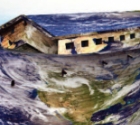 (215x300)-1451810212.jpg)
The documentary film, The Children's House, was screened on February 20th to members of Esra's Cinema Club at Yad Lebanim in Raanana. Its director, Tamar Feingold, conceived the idea for this project on learning that preparations were underway for an exhibition in which artists born and raised in kibbutzim would show artworks reflecting their negative childhood experiences of communal living, when contacts with parents were limited to a short daily visit. Basic details of this exhibition (The Group and the Kibbutz in the Israeli Collective Consciousness) by curator Tally Tamir, 2005, Helena Rubinstein Pavilion of the Tel Aviv Museum, were not included in the film.
Aside from featuring the activities of architect Hagai Tamir, an ex-kibbutznik who designed a replica of a children's house within the exhibition space, Feingold chose to track the creative process of six of the 21 participating artists. She intersperses their visits to the kibbutz and the buildings once housing the children's sleeping quarters with film footage taken of the children's houses dating from the 1950s and '60s. One artist, Idit Levavi-Gabai (raised on Kibbutz Merhavia) appears in most sequences to talk about her miserable childhood. She recalls, for instance, that the happiest night of the year was when the children's houses were receiving their annual coat of paint and she was allowed to sleep in the parents' home.
One gains the impression from this film that the participants in the exhibition were aiming to exorcise painful memories through their artwork. Shown, for example, and inspired by memories of lonely, fear-filled nights, were Shuli Natan's tiny bed, illuminated by a white night light but surrounded by darkness: and Shula Kobo's huge digital prints based on photographs from the 1950s depicting naked children huddled together in a shower room: images alluding to both the total lack of privacy and to the loaded issue of boys and girls taking communal showers.
.jpg)
Feingold has been extremely effective in highlighting the grievances of the 'children' of the kibbutz, many of whom declare that a black hole remains in their adult lives due to the early deprivation of parental warmth and intimacy. On the other hand, she has not adequately presented the ideological concepts that led the parent generation to separate themselves from their children. Interviewed, one elderly survivor of this group remarks: "We didn't intend to be cruel"; while another states quite simply: "We gave the children over to professional educators to leave ourselves free to work." In fairness to the pioneers who dared to experiment with a new style of living, their case should have been presented in greater depth, possibly by means of a short interview with a historian.
In general, Feingold's film proved to be an absorbing viewing experience, moving one's mind from the kibbutz and the problems arising from communal living to contemporary issues involving parenting and interfamily relationships. As a historical document, it would have been appropriate to end with a few written lines explaining that the children's houses had mostly been closed by the end of the 1980s due to ideological rethinking and social pressure.
The film, in Hebrew with English subtitles, was produced by Shula Speigel. It was sponsored by the New Foundation for Cinema and Television and the Second Channel for Radio and TV and is distributed by Ruth Diskin Films. It is due to be shown on TV in the near future.
 (350x156)-1452331757.jpg) Magazine Volunteers on a Summer's Evening
Magazine Volunteers on a Summer's Evening (350x246)-1452331346.jpg) ESRA Tel Aviv in the Community
ESRA Tel Aviv in the Community Honoring our Distributors of over 25 years
Honoring our Distributors of over 25 years Art from the Heart
Art from the Heart Jewish Art Returns to Jerusalem
Jewish Art Returns to Jerusalem Musical Treats
Musical Treats